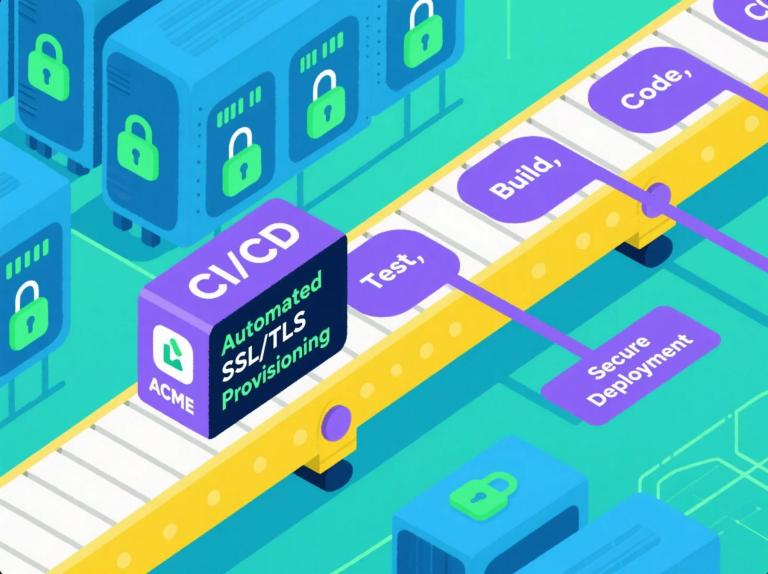
Alright, let's talk DevOps. You're shipping code faster than a caffeinated cheetah on a skateboard, deploying multiple times a day, and living that CI/CD dream, right? It’s awesome! But then… there’s that one little gremlin that loves to throw a wrench in the works: the SSL/TLS certificate. Just when you think everything's smooth sailing, BAM! Browser warnings pop up because someone, somewhere, forgot to renew or correctly install that crucial piece of your security puzzle. Annoying, isn't it?
Manually managing SSL/TLS certificates in a fast-paced DevOps environment is like trying to change the tires on a Formula 1 car with a rusty wrench during a pit stop – it’s slow, error-prone, and frankly, a bit anachronistic. In a world стремления к automation for everything, why should certificate management be left in the manual dark ages? The good news? It doesn’t have to be! Let’s explore how you can weave SSL/TLS automation átomos_субатомные into your CI/CD pipelines and achieve that sweet, sweet "set-it-and-forget-it" (almost!) security.
Why Manual SSL/TLS Management is a DevOps Anti-Pattern
Before we jump into the "how," let's quickly agree on "why" manual certificate management is a total party pooper in a DevOps setup:
It’s a Speed Bump (or a Wall!): CI/CD is all about velocity. Stopping your deployment train to manually request, validate, install, and test a certificate? That’s a surefire way to kill your momentum.
Humans Make Mistakes (Oops!): Forgetting a renewal date (we’ve all been there, or know someone who has!), messing up a configuration file, or installing the wrong certificate chain can lead to downtime, broken user trust, and frantic firefighting.
Security Risks Galore: An expired certificate isn't just an ugly browser warning; it's an open invitation for man-in-the-middle attacks. Misconfigurations can also expose vulnerabilities.
It Just Doesn't Scale: Got a handful of microservices? Maybe you can (painfully) manage. Got hundreds or thousands, each needing its own cert, potentially with short lifespans? Manual management becomes an operational nightmare. Imagine trying to keep track of all those expiry dates – you'd need a spreadsheet the size of Texas!
Enter the Automation Heroes: ACME and Let's Encrypt
Thankfully, some very smart people felt our pain and gave us the tools for automated salvation. The star of this show is the ACME (Automated Certificate Management Environment) protocol. Think of ACME as a universal language that allows your servers to automatically talk to Certificate Authorities (CAs) to request, renew, and manage certificates without any human intervention.
And who’s the most famous CA speaking this ACME language? Let's Encrypt! They burst onto the scene offering free, automated, and open SSL/TLS certificates. Let's Encrypt, powered by ACME, basically handed us the keys to the automated SSL kingdom, making HTTPS accessible and manageable for everyone. While Let's Encrypt is a fantastic option, it's also worth noting that more and more traditional CAs are adopting ACME, broadening your choices.
Wiring It Up: SSL/TLS Automation in Your CI/CD Pipeline
So, how do you actually get this automated magic into your CI/CD pipeline? Here’s a practical, step-by-step approach:
Choose Your ACME Client/Tool:You'll need an ACME client – a piece of software that speaks the ACME protocol. There are tons of great open-source options:
Certbot: Probably the most well-known, very versatile.
acme.sh: A popular shell script client, super lightweight, and dependency-free.
Various language-specific libraries and tools (Go, Python, Node.js, etc.). The key is to pick one that integrates well with your existing CI/CD tools (Jenkins, GitLab CI, GitHub Actions, Azure DevOps, you name it) and your server environment.
Automate Certificate Issuance and Renewal:This is where your CI/CD pipeline really starts to shine. You can script the entire process:
Requesting: The ACME client initiates a request for a new certificate or a renewal.
Domain Validation: The CA needs to verify you actually own the domain. ACME supports different challenge types, like HTTP-01 (placing a file on your web server) or DNS-01 (creating a specific DNS record). Your pipeline can automate these validation steps.
Renewal Logic: Most ACME clients can automatically check if a certificate is nearing expiry and initiate renewal. Your pipeline should treat certificate renewal like any other automated test – it just runs periodically and keeps things healthy and secure. No more panicked "expiry eve" scrambles!
Securely Store and Distribute Your Certificates:Once your ACME client gets a new certificate (which includes the private key, public cert, and intermediate chain), where does it go? You definitely don't want to commit private keys to your Git repo!
Use secure secret management systems like HashiCorp Vault, Kubernetes Secrets, AWS Secrets Manager, Azure Key Vault, etc.
Your CI/CD pipeline can then securely fetch these certificates and deploy them to the right places: your web servers (Nginx, Apache), load balancers, API gateways, or Kubernetes Ingress controllers.
Automate Deployment and Verification:The final step in the pipeline is getting the new certificate live and making sure it works.
Your deployment scripts should be able to gracefully update your server configurations to use the new certificate (e.g., reloading Nginx without dropping connections).
Include an automated verification step: a simple HTTPS request to your site, or a more thorough SSL check, to confirm the new certificate is correctly installed and trusted.
While setting up this DIY automation can be incredibly powerful, it's also worth noting that some hosting platforms or specialized service providers are increasingly offering more integrated or managed SSL solutions. For instance, when leveraging CDN services, such as those you might explore with
Beyond the Basics: Leveling Up Your Automation
Once you've got the fundamentals down, you can explore even cooler stuff:
Wildcard & Multi-Domain (SAN) Certificates: Most ACME clients support these, allowing you to secure multiple subdomains or different domains with a single certificate, simplifying management.
Centralized Management: For larger organizations, tools that provide a central dashboard for all your automated certificates can be a lifesaver.
Robust Monitoring & Alerting: While automation is great, you still need to know if something goes wrong (e.g., a renewal fails for some reason, or a certificate is unexpectedly nearing expiry). Integrate alerts into your existing monitoring system.
The Sweet, Sweet Benefits of SSL/TLS Automation in DevOps
Why go through all this effort? The payoff is huge:
Warp Speed Agility: No more waiting days or weeks for manual certificate processes. New services can get HTTPS enabled instantly as part of their deployment.
Fort Knox Security: Significantly reduces the risk of expired certificates – a common and embarrassing security hole. Automated processes also ensure consistent, correct configurations.
Happier Ops Teams (and Devs!): Frees up your valuable human resources from tedious, repetitive, and error-prone manual work. Let the robots handle it!
Scales Like a Dream: Adding new services or scaling out existing ones? Your automated certificate management just scales with you.
Wrapping It Up: Ditch the Manual, Embrace the Auto!
In today's high-velocity DevOps landscape, manually wrestling with SSL/TLS certificates feels like trying to send a message by carrier pigeon when everyone else is on fiber optic. It’s slow, unreliable, and just doesn’t fit the agile paradigm.
Automating your SSL/TLS certificate lifecycle through protocols like ACME and tight integration with your CI/CD pipelines isn't just a "nice-to-have" anymore; it's a fundamental best practice for modern, secure, and efficient operations. So, stop the renewal reminder madness! Let your pipelines do the heavy lifting, and empower your teams to focus on what they do best: building and shipping awesome, secure applications to your users. Your future self (and your security team) will thank you!

